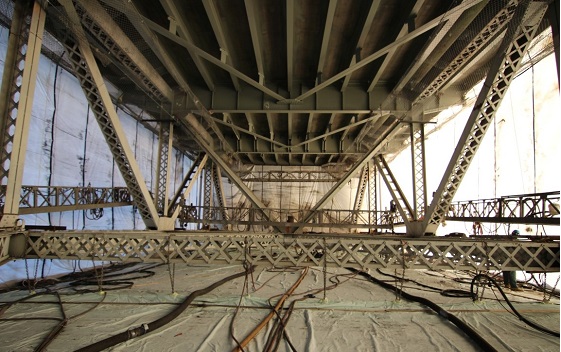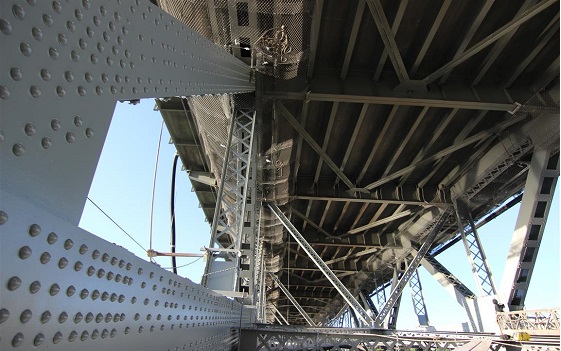The George Washington Memorial Bridge — or the Aurora Bridge, as it’s more commonly known — is a 2,945-foot (897.6 m) long, 70-foot (21.3 m) wide cantilever and truss structure that spans Lake Union and connects the Queen Anne and Fremont neighborhoods in Seattle, Wash. Opened to traffic on February 22, 1932, the Aurora Bridge was the first major highway bridge built in Seattle and was later listed on the National Register of Historic Places.
But as one might expect from a structure nearly nine decades old, the bridge had seen better days. In fact, it exhibited “a combination of chalked and weathered paint, as well as pack rust and pinpoint rust in certain areas,” said Nick Capuzello, corporate health and safety officer for Liberty Maintenance Inc. Factoring in areas that needed steel repair, including the replacement of about 3,000 rivets, Capuzello concludes that the bridge “should’ve been recoated several years ago.”
Setting the Stage
Established in 1985, Liberty Maintenance Inc. is Youngstown, Ohio-based surface prep and coatings contractor that specializes in bridge cleaning and painting projects. According to Capuzello, about 95 percent of their projects involve bridges, including some of the most complex steel structures in the country. As a contractor with accreditation under the NACE International Institute Contractor Accreditation Program (NIICAP) and the International Union of Painters and Allied Trades (IUPAT), Liberty was able to enter a low-bid process with the Washington State Department of Transportation (WSDOT), which owns and operates the Aurora Bridge.
After submitting the winning bid and meeting the prerequisite of Society for Protective Coatings (SSPC) QP1 and QP2 certification, Liberty embarked upon the project to sand blast and recoat approximately 600,000 square feet (55,741.9 m2) of steel. And this project was far from a “quickie” — in fact, it was projected for 391 working days!
To further complicate matters, the crew had limited space to operate due to the dense urban environment in which the bridge was situated. The crew had several logistical obstacles, including the floating home communities of Queen Anne and Fremont, nearby businesses, and even protected wildlife living on the bridge itself. Thus, they set up four staging areas underneath the bridge while maintaining 100 percent tie-off. Environmental considerations were also taken into account, including daily air quality checks with total suspended particulate monitors from ESH-International to ensure that the project was above the action level for lead.
A few subcontractors were brought in to remove the deck overlay, make deck repairs and joint modifications, and lay the hot mix asphalt to create six new driving lanes. To safely execute this work, existing lanes were closed from Wednesday night to Monday morning over the course of four weeks. While these subcontractors worked, Nick Hadsell, Liberty’s project manager, coordinated with local businesses to ensure that the closures would not harm consumer traffic.
Blasting and Coating
The Liberty crew began work in April 2018 and wrapped up in September 2019. During that period, Capuzello estimates there were about 60 full-time employees on the project, including himself, Hadsell, and company vice president and owner Nick Frangos. On-site employees included 12 blasters, a 15-person painting crew, a 10- to 12-person rigging crew, and miscellaneous crew members in support roles. Each crew had its own foreman, two quality control specialists, and two health and safety officers.

As if the Aurora Bridge project wasn’t daunting enough, Liberty was also working on two other WSDOT bridge projects at the same time. Once Liberty completed its other WSDOT projects, it was able to deploy additional crew members to the Aurora Bridge project, resulting in a crew that ballooned up to 70 members at certain points.
The crew installed Occupational Safety and Health Administration (OSHA) compliant corrugated deck sheeting from Safespan as their primary work platform, said Capuzello, who also served as quality control supervisor. The vertical parts of the bridge were accessed using Sky Climber air hoists and 30-foot (9.1 m) stages. Crew members employed 3M DBI-SALA ExoFit harnesses and double lanyards, as well as personal protective equipment (PPE) such as 3M respirators, safety vests, eye protection, and hard hats.
Next, the crew erected Class 1A containments made from double-coated airbag material. These 80,000 cfm (37.8 m3/min.) dust collectors were custom made by Eagle Industries. “The tarps we used were all brand new,” said Hadsell. “With the area being so congested and high profile, we wanted to take the upmost effort to protect our surroundings and the public.”
Wearing RPB Nova 3 series respirator blast hoods, blasters used copper slag expendable abrasive supplied by Marco and BlastOne to perform abrasive blasting. In doing so, they achieved the NACE No. 2/SSPC Surface Preparation (SP) 10, “Near-White Metal Blast Cleaning” standard. Once the surface was prepped, painters applied moisture-cured urethane coatings from local manufacturer Wasser. Wielding WIWA and Graco spray pumps, they applied the coatings in four stages: a primer coat of MC-Zinc 100 at 3 to 5 mils (76.2 to 127.0 microns) dry film thickness (DFT); a full middle coat and stripe coat of MC-Ferrox B 100 at 3 to 5 mils and 2 to 3 mils (50.8 to 76.2 microns) DFT, respectively; and a finish coat of MC-Luster 100 at 2 to 4 mils (50.8 to 101.6 microns) DFT.
“We had a few choices of paint companies to use, but Wasser is the go-to paint company in the area,” said Capuzello. “Being in the Seattle area where there’s so much rainfall, they already had the kinks worked out in terms of weatherproofing. So we went with them, and we’re happy that we did.” He added that these moisture-cured urethane coatings eliminated humidity restrictions and, consequently, allowed crew members to work longer.
Additionally, the crew used the Sikaflex 1a moisture-cured sealant and Sherwin-Williams Macropoxy 920 Pre-Prime for bridge areas where pack rust was removed. In terms of PPE, the paint crew had 100 percent fall protection and wore 3M full-face respirators, Marco gloves, and coveralls.
Awarded for Excellence
Aside from a winter shutdown period from September 20 to January 15, the Liberty crew consistently worked eight- to 10-hour days for five to six days each week, and for more than a full calendar year. In the end, they completed the project in less time than originally contracted — instead of 391 working days, they finished with 33 working days to spare.
This year, the contractor received two Partnership for Excellence awards at an annual event co-sponsored by WSDOT and the Associated General Contractors (AGC) of Washington. In addition to their work on the Aurora Bridge project, Liberty was also awarded for another bridge painting project in the state.
No matter the contractor, receiving such high recognition for two out of three WSDOT bridge projects is an enviable accomplishment. As Hadsell put it, “it was something that really puts a feather in your cap!”
